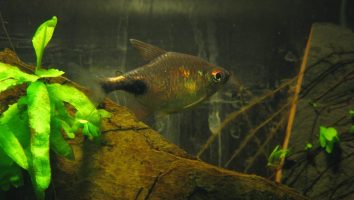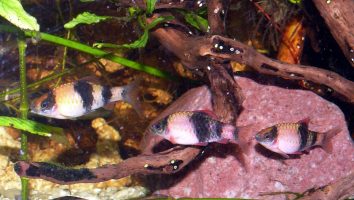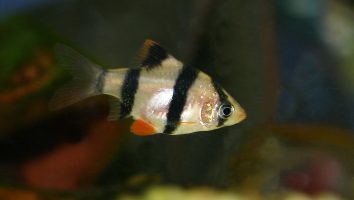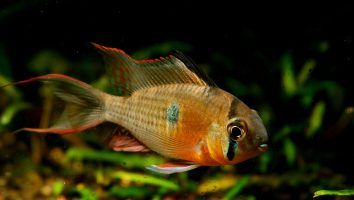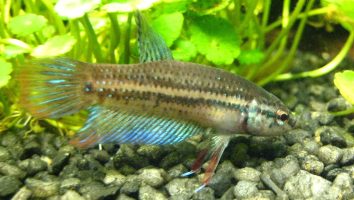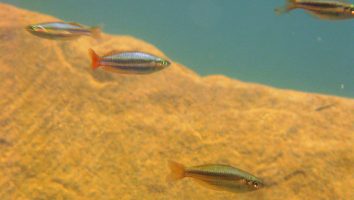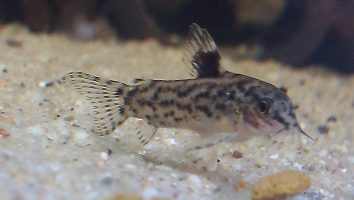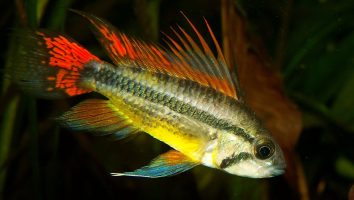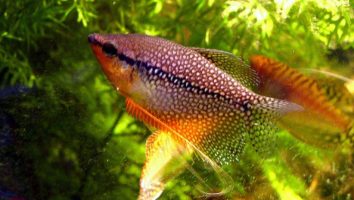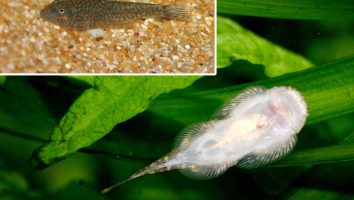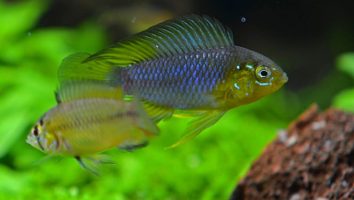The croaking gourami (Trichopsis vittata) is a beautiful freshwater fish that’s perfect for beginner aquarium hobbyists.
This species is easy to care for, can be kept in a small tank, and is very peaceful.
The croaking gourami gets its name from the croaking noise males make during breeding season. This is done to attract females and to warn other males away from their territory.
While the croaking gourami is peaceful, it can be aggressive towards other males of the same species. If you want to keep more than one croaking gourami, we recommend keeping at least 2 females for every 1 male.
Table of contents
Species overview
Croaking gouramis (Trichopsis vittata) are found in a wide variety of locations across Southeast Asia. This includes Thailand, Vietnam, Laos, and Cambodia.
They live in slow-moving water with a lot of vegetation. This can be in the form of floating plants, rooted plants, or algae.
Croaking gouramis get their name from the mating call that the males make to attract females. This call sounds very similar to the croak of a frog and can be quite loud, especially in a small aquarium.
These fish are popular in the aquarium trade due to their beautiful colors and interesting patterns. They are also very peaceful fish, which makes them a good choice for community tanks.
Appearance
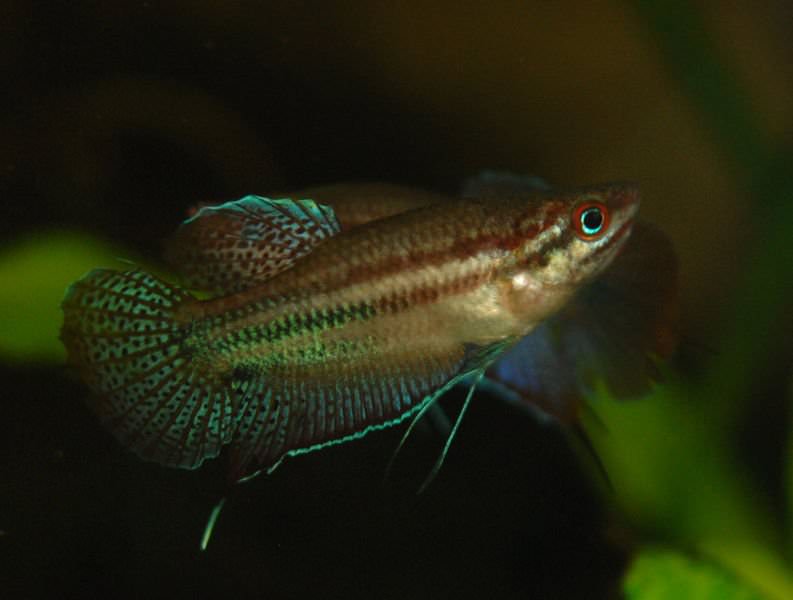
The croaking gourami is a freshwater fish that is easily recognizable due to its unique appearance. As the name suggests, these fish are known for the croaking noise they make.
The body of a croaking gourami is long and slender. They have a relatively small head with large eyes. The mouth of a croaking gourami is located at the bottom of the head and is downturned.
These fish have a dorsal fin and an anal fin. The dorsal fin is tall and begins at the middle of the back. The anal fin is shorter and located at the back of the fish. The caudal fin is forked and located at the end of the fish.
The croaking gourami is a brightly colored fish. The body is typically a greenish-brown color with dark markings. The fins are often brightly colored and can be striped or spotted.
Lifespan
Croaking gouramis have an average lifespan of 3 to 5 years. However, there have been reports of these fish living up to 10 years in captivity.
The lifespan of a croaking gourami is largely determined by the water conditions in their tank. These fish are very sensitive to water quality and even a slight change can impact their health.
That’s why it’s so important to keep a close eye on your croaking gourami’s tank and make sure the water quality is always up to par.
Size
The size of a full-grown Croaking Gourami can vary quite a bit based on the species. The Dwarf Croaking Gourami only grows to be about 1.6 inches long while the Giant Gourami can get up to 18 inches in length! Most Croaking Gouramis that you’ll find in the fish trade fall somewhere in the middle at around 4-6 inches in length.
Tank
Tank Size
The minimum tank size for croaking gouramis is 10 gallons. If you’re planning on keeping more than one fish, you should add at least 5 gallons per fish.
While croaking gouramis are not as large as some of the other fish on this list, they are still relatively big fish. They also produce a lot of waste, so you need to make sure you have a filter that can handle the load.
Water Parameters
The croaking gourami is a tropical freshwater fish that’s native to Southeast Asia. In the wild, they inhabit slow-moving rivers and streams with plenty of vegetation.
This is a pretty easy fish to care for since they’re pretty adaptable. They can live in a wide range of water conditions, but they do prefer water on the softer side.
Here are a few water parameters to keep in mind when setting up a croaking gourami tank.
- Water temperature: 72 to 82 degrees Fahrenheit
- pH levels: 6.0 to 8.0
- Water hardness: 4 to 20 dGH
- Alkalinity Levels: 3 to 12 dKH
What To Put In Their Tank
Croaking gouramis are a bit more delicate than some of the other freshwater fish on this list. This means that you need to take a different approach when setting up their tank.
The first thing you need to do is choose a substrate that’s soft and smooth. These fish are constantly grazing on the bottom of the tank for food, which can easily damage their delicate fins. A substrate like sand or small gravel is ideal.
The next thing you need to do is add some plants. These fish love to hide in vegetation, so it’s important to give them some places to do that. We recommend going with floating plants since they’re less likely to be disturbed (but you can do whatever you want).
You should also add some driftwood or rocks to the tank. These provide some much-needed hiding places for these fish. They’ll also help create some different levels in the tank, which is important since these fish like to swim in all different areas.
Common Diseases
The croaking gourami is a freshwater fish that is native to Southeast Asia. They’re a popular choice for aquariums because of their vibrant colors and interesting croaking noise.
While they’re a hardy fish, there are still a few diseases that you need to be aware of. The most common one is ich. This is a parasitic infection that will cause white spots to form on the body of your fish.
If left untreated, ich can be fatal. The good news is that it’s relatively easy to treat. There are a number of ich medications available that will quickly eradicate the parasite.
Another common disease is gill flukes. This is an infection of the gills that can make it difficult for your fish to breathe. Gill flukes are usually caused by poor water quality, so the best way to prevent them is to keep the tank clean.
If you notice your fish gasping for air or rubbing their gills on the substrate, it’s a good idea to check for gill flukes.
Fortunately, both of these diseases are relatively easy to treat. As long as you catch them early, your fish should make a full recovery.
Behavior & Temperament
The croaking gourami is a generally peaceful fish that does best when kept in pairs or small groups. They are shy by nature and will often hide among plants or other decorations in their tank. When kept in pairs, one croaking gourami will often become the dominant fish while the other remains submissive.
While these fish are peaceful by nature, they can become aggressive when they feel threatened. They have been known to attack other fish and even nip at the fins of their tank mates. For this reason, it’s best to avoid keeping them with other fish that have long fins or are easily intimidated.
Croaking gouramis are also known to be jumpers. They have been known to jump out of tanks that are not properly covered. For this reason, it’s important to make sure your tank is well covered to prevent your fish from escaping.
Tank Mates
In general, you want to avoid keeping croaking gouramis with larger, more aggressive fish. These fish are relatively small and timid. They’re also not the best swimmers, so they can have a hard time getting away from trouble.
With that said, there are still plenty of compatible tank mates for croaking gouramis. These fish do best in a community tank with other peaceful species.
Some good options include:
- Neon Tetras
- Corydoras Catfish
- Otocinclus Catfish
- Ember Tetras
- Ghost Shrimp
- Guppies
- Platies
Breeding
The croaking gourami is a beautiful fish that is not too difficult to breed in captivity.
To start, you will need to set up a breeding tank that is at least 20 gallons in size. The water should be soft and acidic, with a temperature between 78 and 82 degrees Fahrenheit.
You will also need to add some plants to the tank. Java moss is a good option, as it will provide shelter for the fry.
Once the tank is set up, you can add a pair of croaking gouramis. It’s best to add one male and one female, although you can add two males if you can’t find a female.
The male will build a bubble nest near the surface of the water. Once the female is ready to lay her eggs, she will release them near the nest. The male will then fertilize them and store them in the bubble nest.
The incubation period takes around 24 hours. After that, the fry will start to hatch. They will be very small and vulnerable, so it’s important to remove the adults from the tank at this point.
The fry will feed on microscopic organisms in the water for the first few days. After that, you can start to feed them baby brine shrimp or other small live foods.
Conclusion
The croaking gourami is an awesome fish that is perfect for beginners and experienced fish keepers alike. They are easy to care for and are very peaceful fish that will get along well with other community fish.
They are also very fun to watch as they interact with their tank mates and explore their surroundings.
We highly recommend this fish to anyone who is looking for a low-maintenance, peaceful, and fun fish to add to their tank!

